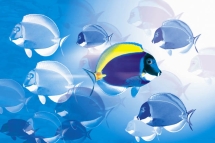ZSI analysis of co-publication and co-patenting among countries in the Danube Region
Bereich: Forschungspolitik & Entwicklung
One of the Danube-INCO.NET project main pillars consists in the provision of analytical evidence on research and innovation in the Danube Region for the policy making system. In such a context, ZSI has recently delivered a study that scrutinises both the co-publications and the co-patents in Danube Region Countries (DRC) and the Western Balkan countries (WBC) for the years of 2003-2013 in order to provide a solid base for the identification of intra-regional thematic strengths and collaboration patterns, to bring to the fore the most active players, centres of excellence, and existing “hot” links between R&I institutions. The Danube-INCO.NET project, which is coordinated by ZSI, focuses indeed on the countries included in the EU Strategy of the Danube Region, but for arguments of comparison, inclusion and cooperation, the project tries to include analysis on the Western Balkan countries as far as possible.
_________
The methodology of the co-publication analysis, presented as a first input, is based on the two main academic citation databases, namely Web of Science and Scopus. The actual analysis of the publication data was carried out along several dimensions: overall co-publication output numbers per country to provide an overview, the internationalisation of publications, the strongest co-publication links among the countries under scrutiny, main scientific research fields, and finally some highlights regarding scientific impact.
As regards the overall co-publication output, the results suggest three country groupings: (1) Austria, Czech Republic, Romania, Hungary, and Ukraine; (2) Serbia, Croatia, Slovenia, Slovakia, Bulgaria; and (3) Bosnia and Herzegovina, FYR of Macedonia, Albania, Moldova, Montenegro, and Kosovo*. However, a common denominator for all of the country groupings is the growth rate which remains relatively stable over the covered period of time.
Internationalisation is defined in this analysis as a proportion of international co-publications with authors from at least two different countries (at least one of which is a DRC or WBC) in the overall publication output of a country. In general, the DRC’s share of international co-publications is between 40-50 %. Smaller countries tend to have a higher share, which is not surprising as their need to collaborate with researchers abroad is usually higher. Moreover, the share of intra-regional co-publication activity in the region’s overall co-publication activity is also between 40-50 %.
Speaking of key regional players in terms of co-publication linkages in the region, Germany is a key leader. Outside the region, France plays the most important role for the researchers from DRC and WBC.
The analysis of the thematic focus of the DR and WBC co-publications revealed a focus on Physics & Astronomy, Chemistry, Biomedical Research, Biology, Mathematics & Statistics, Earth & Environmental Sciences, General Science & Technology.
As regards the patent output of the countries at hand, the analysis – based on the EU Patent Office’s PATSTAT database – examines the co-invention and foreign ownership patterns in the Danube region between 2003-2013.
In terms of thematic specialisations, the region's patent application output is comparatively strong in the 'mechanical engineering', textiles, 'operations and transport' and, to some degree, the ‘fixed constructions’ area. The share of DR and WBC applications in global applications is beyond 20 % in all the mentioned fields, which means that one DR inventor is involved in every fifth patent application globally. In other areas like 'human necessities', physics or electricity, these shares are around 10%. There is no technology area with large scale knowledge flow out of the Danube region (this would be indicated by a mismatch between inventor and applicant shares with the latter being significantly lower). The numbers rather indicate that the region is a net recipient of knowledge flows (indicated through IP ownership).
Patenting in the region is more internationalised than the global average: Around 12 % of the patent applications with at least one DR or WBC inventor involve inventors from two or more countries. The global average is a co-invention share of around 6 %.
Apart from the linkages between Germany and other major countries from the region, relevant co-invention relationships exist between: CZ-SK, MD-RO, AT-SK, MD-UA, AT-HU, and AT-CZ. Interestingly, if we exclude Germany, Austria's co-invention linkages are not the dominating ones as one might expect given its overall application output. Other countries' inventive behaviour is more integrated. But considering its patent application output, Ukraine is less integrated into the regional co-invention networks.
Please refer to the document below for more details on methodology and results.
Suggested citation
- Lampert, Dietmar, Philipp Brugner, Katharina Büsel et al. (2015): Co-publication and co-patenting analysis among countries in the Danube Region. Danube- INCO.NET. Deliverable 4.16. Available from: www.zsi.at
AutorInnen: Brugner, P., Dall, E., Degelsegger-Márquez, A., Lampert, D., Riedmann , K., Simon, J., Wagner, I., Zupan, I., Florina Piroi (Vienna University of Technology)
Entstanden im Zusammenhang mit folgender Veranstaltung: Project Danube-INCO.NET with public presentation in Vienna
Downloads:
Verwandte Artikel:
- Projekt: Danube-INCO.NET
- Publikation: Kopublikationsanalyse Wissenschaft & Wirtschaft 2009-2014
Tags: bibliometrics, co-publication analysis, Danube Region, patent analysis, scientometrics













































